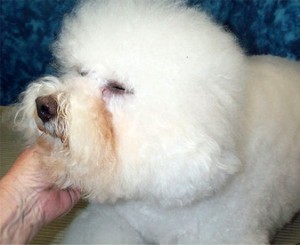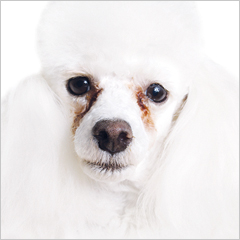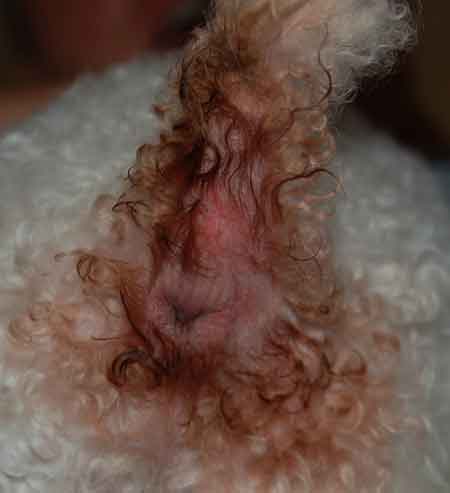Tear Staining
Due to
Epiphora
(Excessive Tearing)
What's On This Page:
Excessive tearing:
Dealing with cats and dogs with excessive watering of the eyes.
On Other Pages about Eye Problems:
Eye Problems in Pets: Intro Page about eye diseases
Epiphora
(Watering of the Eyes or Excessive Tearing)
Epiphora is the medical term for excessive tearing or watering of the eyes. It commonly causes staining of the fur under the eyes. There are many causes, but the most common are chronic irritation or inflammation of the eyes or an abnormality in the tear drainage system.
A related problem is not truly epiphora, but appears to be so, and that's a blocked tear duct. Normally, tears leave the eye by going down a tear duct into the nasal passages, but if the duct is clogged up or blocked, the tears spill over the lower lid ... looking just like excessive tears.
Common causes of chronic irritation in dogs include infections, allergies and abnormalities of the eyelashes and eyelids. Shallow eye sockets, entropion (rolled in eyelids), excessive hair around the eye (that "wicks" the tears out of the eye) and blocked tear ducts are frequent underlying causes. The most serious potential cause is that the eye ball is getting bigger due to glaucoma. Pets with excessive tearing NEED to have their eye pressure checked. If we detect glaucoma in the early stages we can save your pet's sight. Vets have very accurate instruments for measuring eye pressure now (TonoPen or TonoVet)
In cats, viral infection is common, which usually causes the eyes to appear mildly or moderately inflamed.
If your dog or cat seems to be tearing excessively, have him or her checked by a veterinarian to determine whether treatment is needed.
Abnormalities of the tear drainage system can be treated by flushing the system and applying medication, but sometimes surgery is required. Sometimes all you have to do is trim excessive hair from near the eye.
Excessive tears in themselves are not a danger to your pet, but it's important to make sure there isn't some reason causing the tears that needs attention.
As you know from your own experience; things that cause your eye to tear are often very irritating and sometimes quite painful. Some breeds have tears that discolor their faces simply because of poor tear drainage, often because of the way the eye bulges out in some breeds such as Boston Terriers or Persian Cats. Or because of inadequate tear duct size in other breeds such as poodles and Maltese dogs. And, of course, this is more noticeable if you have a white dog or cat.

Website Directory
Home The Human-Animal Bond The History of Veterinary Medicine About our No Kill Shelter The FoxNest Veterinary Hospital
"What To Expect When You Go To The Vet"
if your pet should have a problem with ...
To include Femoral Head Removal, Hip Dysplasia, Anterior Cruciate Ligament Injuries, Panosteitis, Radiographic Demonstrations, Disc Disease, and Bone Surgery
Strokes, Vascular Diseases, Anemias, DVT, DIC, Blood Parasites, Rat Poison, & Bleeding disorders
Cardiology Heart disease in Cats, Cardiac Hypertrophy, Valvular disease, Cardiac Insufficiency, Congestive Heart Failure, Heartworm Disease, and a little history about the milestones in treating heart disease
Cats: general information page and directory of diseases and problems specific to cats including vaccine recommendations, leukemia, feline viral infections, feline upper respiratory disease and cats that just aren't feeling well.
Dermatology: Skin problems including allergies, rashes, bacterial infections, and itching. Hair Loss, Yeast Infections, Hormonal Problems
Heart disease; Cardiac diseases, vascular diseases, stroke, & heartworms
Hormone Diseases: Diabetes, Thyroid Disease, Cushing's Disease or Hypercortisolism, Addison's disease or Hypocortisolism, Pancreatitis, obesity as a disease
Infectious Diseases Colds, Distemper, Parvo, Leptospirosis, Bruceellosis, Panleukopenia, Feline AIDS, Leukemia, Hepatitis, Kennel Cough, Ringworm, Rabies, FIP, Canine Herpes, Toxic Shock Syndrome, & More
Intestinal problems: diarrhea, constipation, torsion, indigestion, and gas. Also pancreatitis, vomiting, esophagitis, colitis, parvo and other types of dysentery
Metabolic Diseases: Diabetes, Thyroid Disease, Cushing's Disease or Hypercortisolism, Addison's disease or Hypocortisolism, Pancreatitis, obesity as a disease
Neural Problems and Diseases: Epilepsy, Rabies, Distemper, FIP, Paralysis, Tetanus, Seizures, Disc Disease, Toxoplasmosis & others
Parasite Problems Fleas, Ticks, Heartworms, Intestinal Worms, Mosquitos, Lice, Mites, and other welfare recipients
Poisons Snakes, Insects, household chemicals, plants, and foods that might poison your pet
Skeletal-Muscular Problems Arthritis, Fractures, ACL, Ligament Injuries, Disc Disease, Pannus, and many other problems of the bones, muscles, tendons, and ligaments
Skin Problems: allergies, rashes, bacterial infections, and itching. Hair Loss, Yeast Infections, Hormonal Problems
Surgery: Spays, Castrations, Testicle Recipes, Soft Tissue Surgery, Hard Tissue Surgery (Bones), C- Sections, Declawing, Tumor Removal and Cancer Surgery
Other Topics on This Site
Zoonotics: Diseases, worms, and parasites people get from pets.
Includes information about Prescription diets used to treat disease, and a discussion about the pet food industry
Includes information about feline and canine heat or estrus, breeding, C-Sections, pyometra or Infected Uterus, dystocia, no milk, mastitis, & brucellosis
Also newborn care, undescended testicles, and alternative to spaying and castration
WildLife Page: Taking care of baby bunnies, squirrels, and birds. A very funny story about beavers, and other misc information
Our Dog Page: a directory of problems of concern in dogs including parvovirus, distemper, canine herpes, and other diseases

 | ||||||



This is interesting; the trail of tears down the cheek appear as rust colored stains because there are iron molecules in tears ... after the water part evaporates ... it leaves behind oxidized iron molecules.
The same iron molecules are in saliva, if you have a pet with white hair, it's easy to see if he or she is licking somewhere excessively.
The picture above of the anal area and the picture to your right show rust colored staining from saliva. Dogs that lick their anal areas excessively often have food or other allergies. And dogs that lick their paws excessively often do so because of air borne allergens.... or anxiety ... or both
Treatment
Step A. Have your vet make sure there isn't an underlying eye disease, allergies, or structural problem that's causing excessive tears.
Step B. If the problem is that a portion of the tears spill over the lower lid instead of draining down the tear duct into the nasal cavities, this sometimes can be fixed by flushing the tear ducts or surgically removing anything blocking the medial canthus of the eye where the tears collect before going down the tear duct (or spilling over the lower lid).
This is often an impossible task... either the duct is simply too small to handle all the tears, the duct is damaged and scarred limiting drainage, or the pet's face is just shaped wrong for effective tear drainage.

Treatment
Step A. Have your vet make sure there isn't an underlying eye disease, allergies, excessive hair, skin folds, or another structural problem that's causing excessive tears.
Step B. If the problem is simply that a portion of the tears spill over the lower lid instead of draining down the tear duct into the nasal cavities, this sometimes can be fixed by flushing the tear ducts or surgically removing anything blocking the medial canthus of the eye where the tears collect before going down the tear duct (or spilling over the lower lid).
This is often an impossible task... either the duct is simply too small to handle all the tears, the duct is damaged and scarred limiting drainage, or the pet's face is just shaped wrong for effective tear drainage. Note the picture of the Persian Cat to your right.
Step C. At any rate, if you have a pet who has healthy eyes but has unsightly tear stains on it's face there are several treatment options available online, at pet stores, and at your vet. There are also recipes for home made treatments involving cider vinegar, milk of magnesia, and Tums (the calcium can bind the iron molecules preventing the unsightly rust color)
The success rate is only so-so. See my comments to your right.
The Persian Cat in the picture above has such a flat face that the tear ducts are squished resulting in tear spillage. Once the water portion of the tears has evaporated, the mucus and oil portions of the tears remain in the fur along with those iron oxide molecules I mentioned above. Lots of dog breeds with flat faces like Pugs are also prone to tear staining.
More about different treatments... continued from Step C to your left: We sell some herbal treats that are supposed to reduce tear stains and also a topical face cleaner made by the same company. We warn anyone buying these products that they seems to work well about a third of the time.... are somewhat helpful about a third of the time... and barely make any difference the rest of the time.
A lot of clients tell me that a product called "Angel Eyes" works well but the active ingredient in Angel Eyes is an antibiotic called Tylosin that works by either binding the iron and/or killing the bacteria on the skin that is partially responsible for changing tears that start out looking like water drops into a brown gunky slime. This product seems to be very safe but we question whether or not the over use of antibiotics for cosmetic purposes might lead to resistant bacteria problems in the future.